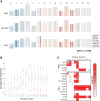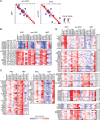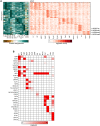Chromatin module inference on cellular trajectories identifies key transition points and poised epigenetic states in diverse developmental processes
- PMID: 28424352
- PMCID: PMC5495076
- DOI: 10.1101/gr.215004.116
Chromatin module inference on cellular trajectories identifies key transition points and poised epigenetic states in diverse developmental processes
Abstract
Changes in chromatin state play important roles in cell fate transitions. Current computational approaches to analyze chromatin modifications across multiple cell types do not model how the cell types are related on a lineage or over time. To overcome this limitation, we developed a method called Chromatin Module INference on Trees (CMINT), a probabilistic clustering approach to systematically capture chromatin state dynamics across multiple cell types. Compared to existing approaches, CMINT can handle complex lineage topologies, capture higher quality clusters, and reliably detect chromatin transitions between cell types. We applied CMINT to gain novel insights in two complex processes: reprogramming to induced pluripotent stem cells (iPSCs) and hematopoiesis. In reprogramming, chromatin changes could occur without large gene expression changes, different combinations of activating marks were associated with specific reprogramming factors, there was an order of acquisition of chromatin marks at pluripotency loci, and multivalent states (comprising previously undetermined combinations of activating and repressive histone modifications) were enriched for CTCF. In the hematopoietic system, we defined critical decision points in the lineage tree, identified regulatory elements that were enriched in cell-type-specific regions, and found that the underlying chromatin state was achieved by specific erasure of preexisting chromatin marks in the precursor cell or by de novo assembly. Our method provides a systematic approach to model the dynamics of chromatin state to provide novel insights into the relationships among cell types in diverse cell-fate specification processes.
© 2017 Roy and Sridharan; Published by Cold Spring Harbor Laboratory Press.
Figures







Similar articles
-
Cell Type-Specific Chromatin Signatures Underline Regulatory DNA Elements in Human Induced Pluripotent Stem Cells and Somatic Cells.Circ Res. 2017 Nov 10;121(11):1237-1250. doi: 10.1161/CIRCRESAHA.117.311367. Epub 2017 Oct 13. Circ Res. 2017. PMID: 29030344 Free PMC article.
-
Reprogramming of cell fate: epigenetic memory and the erasure of memories past.EMBO J. 2015 May 12;34(10):1296-308. doi: 10.15252/embj.201490649. Epub 2015 Mar 27. EMBO J. 2015. PMID: 25820261 Free PMC article. Review.
-
Transient and Permanent Reconfiguration of Chromatin and Transcription Factor Occupancy Drive Reprogramming.Cell Stem Cell. 2017 Dec 7;21(6):834-845.e6. doi: 10.1016/j.stem.2017.11.007. Cell Stem Cell. 2017. PMID: 29220667
-
Chromatin dynamics during cellular reprogramming.Nature. 2013 Oct 24;502(7472):462-71. doi: 10.1038/nature12749. Nature. 2013. PMID: 24153299 Free PMC article. Review.
-
Going up the hill: chromatin-based barriers to epigenetic reprogramming.FEBS J. 2021 Aug;288(16):4798-4811. doi: 10.1111/febs.15628. Epub 2020 Dec 6. FEBS J. 2021. PMID: 33190371 Review.
Cited by
-
Mechanism of activation and the rewired network: New drug design concepts.Med Res Rev. 2022 Mar;42(2):770-799. doi: 10.1002/med.21863. Epub 2021 Oct 25. Med Res Rev. 2022. PMID: 34693559 Free PMC article. Review.
-
Inferring time series chromatin states for promoter-enhancer pairs based on Hi-C data.BMC Genomics. 2021 Jan 28;22(1):84. doi: 10.1186/s12864-021-07373-z. BMC Genomics. 2021. PMID: 33509077 Free PMC article.
-
Dynamic regulatory module networks for inference of cell type-specific transcriptional networks.Genome Res. 2022 Jul;32(7):1367-1384. doi: 10.1101/gr.276542.121. Epub 2022 Jun 15. Genome Res. 2022. PMID: 35705328 Free PMC article.
-
Chromatin-state discovery and genome annotation with ChromHMM.Nat Protoc. 2017 Dec;12(12):2478-2492. doi: 10.1038/nprot.2017.124. Epub 2017 Nov 9. Nat Protoc. 2017. PMID: 29120462 Free PMC article. Review.
-
A novel bivalent chromatin associates with rapid induction of camalexin biosynthesis genes in response to a pathogen signal in Arabidopsis.Elife. 2021 Sep 15;10:e69508. doi: 10.7554/eLife.69508. Elife. 2021. PMID: 34523419 Free PMC article.
References
-
- Caruana R. 1997. Multitask learning. Mach Learn 28: 41–75.
-
- Chen X, Xu H, Yuan P, Fang F, Huss M, Vega VB, Wong E, Orlov YL, Zhang W, Jiang J, et al. 2008. Integration of external signaling pathways with the core transcriptional network in embryonic stem cells. Cell 133: 1106–1117. - PubMed
-
- Dempster A, Laird N, Rubin D. 1977. Maximum likelihood from incomplete data via the EM algorithm. J R Stat Soc Series B (Methodol) 39: 1–38.
Publication types
MeSH terms
Substances
Grants and funding
LinkOut - more resources
Full Text Sources
Other Literature Sources
Molecular Biology Databases
